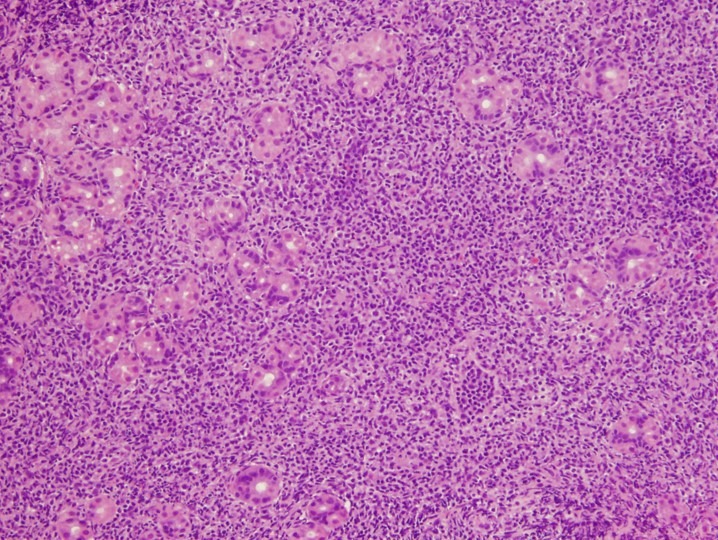Back
Poster Session E - Tuesday Afternoon
E0724 - Helicobacter pylori Negative Mucosa Associated Lymphoid Tissue
Tuesday, October 25, 2022
3:00 PM – 5:00 PM ET
Location: Crown Ballroom

Siva Santosh Kumar Gandu, MD
LSUHSC
Shreveport, LA
Presenting Author(s)
Siva Santosh Kumar Gandu, MD, Pranavteja Gutta, MD, Sudha Pandit, MD
LSUHSC, Shreveport, LA
Introduction: Gastric mucosa-associated lymphoid tissue (MALT) is a rare primary gastric lymphoma, which commonly occurs in association with Helicobacter Pylori. H. pylori-negative MALT is reported in around 5% of the cases, the etiopathogenesis, and management of which is still not thoroughly understood.
Case Description/Methods: A middle-aged African American male with a history of peptic ulcer disease, alcohol, and tobacco abuse, presented to the gastroenterology clinic with dyspepsia. The initial esophagogastroduodenoscopy (EGD) was negative for acute findings and the gastric biopsy showed incomplete type intestinal metaplasia and was negative for H. pylori. The patient was treated with a proton pump inhibitor and a repeat endoscopy with gastric mapping was planned. This revealed localized areas with atrophic mucosa and nodularity without clear demarcation. The gastric body showed prominent rugae with edematous friable mucosa. Gastric biopsy was sent for flow cytometry in suspicion of lymphoma, which confirmed the diagnosis of B cell, non-Hodgkins lymphoma (NHL), with the presence of intestinal metaplasia. Cytology revealed a t(11;18) chromosomal translocation. Repeat H. pylori serology, and stool antigen was negative. Positron emission tomography with computed tomography (PET/CT) revealed local involvement of gastric mucosa and peri-gastric lymph node involvement. The patient was treated with involved-field radiation without eradication therapy resulting in complete endoscopic and histologic remission.
Discussion: The indolent nature of this tumor results in delayed diagnosis and treatment. Additionally, some studies suggest false negative tests for H. Pylori may play a role in the diagnosis of H. Pylori negative gastric MALT. The reliability of the serological test has been studied, showing disagreement between initial and repeat testing especially in non-Hispanic and black individuals. The treatment and management of H. pylori negative gastric MALT remain controversial, as some studies show benefits and complete remission with antibiotic-based therapy. Additionally, some studies show that cytological identification of t(11;18) can help identify patients expected to have a low therapeutic response to H. pylori antibiotic eradication therapy. This patient had many risk factors for developing gastric cancer, however Gastric MALT rarely occurs in the absence of H. pylori. The patient's response to involved-field radiation without eradication therapy also makes this case unique.

Disclosures:
Siva Santosh Kumar Gandu, MD, Pranavteja Gutta, MD, Sudha Pandit, MD. E0724 - Helicobacter pylori Negative Mucosa Associated Lymphoid Tissue, ACG 2022 Annual Scientific Meeting Abstracts. Charlotte, NC: American College of Gastroenterology.
LSUHSC, Shreveport, LA
Introduction: Gastric mucosa-associated lymphoid tissue (MALT) is a rare primary gastric lymphoma, which commonly occurs in association with Helicobacter Pylori. H. pylori-negative MALT is reported in around 5% of the cases, the etiopathogenesis, and management of which is still not thoroughly understood.
Case Description/Methods: A middle-aged African American male with a history of peptic ulcer disease, alcohol, and tobacco abuse, presented to the gastroenterology clinic with dyspepsia. The initial esophagogastroduodenoscopy (EGD) was negative for acute findings and the gastric biopsy showed incomplete type intestinal metaplasia and was negative for H. pylori. The patient was treated with a proton pump inhibitor and a repeat endoscopy with gastric mapping was planned. This revealed localized areas with atrophic mucosa and nodularity without clear demarcation. The gastric body showed prominent rugae with edematous friable mucosa. Gastric biopsy was sent for flow cytometry in suspicion of lymphoma, which confirmed the diagnosis of B cell, non-Hodgkins lymphoma (NHL), with the presence of intestinal metaplasia. Cytology revealed a t(11;18) chromosomal translocation. Repeat H. pylori serology, and stool antigen was negative. Positron emission tomography with computed tomography (PET/CT) revealed local involvement of gastric mucosa and peri-gastric lymph node involvement. The patient was treated with involved-field radiation without eradication therapy resulting in complete endoscopic and histologic remission.
Discussion: The indolent nature of this tumor results in delayed diagnosis and treatment. Additionally, some studies suggest false negative tests for H. Pylori may play a role in the diagnosis of H. Pylori negative gastric MALT. The reliability of the serological test has been studied, showing disagreement between initial and repeat testing especially in non-Hispanic and black individuals. The treatment and management of H. pylori negative gastric MALT remain controversial, as some studies show benefits and complete remission with antibiotic-based therapy. Additionally, some studies show that cytological identification of t(11;18) can help identify patients expected to have a low therapeutic response to H. pylori antibiotic eradication therapy. This patient had many risk factors for developing gastric cancer, however Gastric MALT rarely occurs in the absence of H. pylori. The patient's response to involved-field radiation without eradication therapy also makes this case unique.

Figure: There is an atypical lymphoid infiltrate compatible with stomach involvement by MALT lymphoma. Oxyntic glands are surrounded by lymphocytes.
Disclosures:
Siva Santosh Kumar Gandu indicated no relevant financial relationships.
Pranavteja Gutta indicated no relevant financial relationships.
Sudha Pandit indicated no relevant financial relationships.
Siva Santosh Kumar Gandu, MD, Pranavteja Gutta, MD, Sudha Pandit, MD. E0724 - Helicobacter pylori Negative Mucosa Associated Lymphoid Tissue, ACG 2022 Annual Scientific Meeting Abstracts. Charlotte, NC: American College of Gastroenterology.
